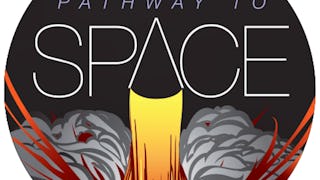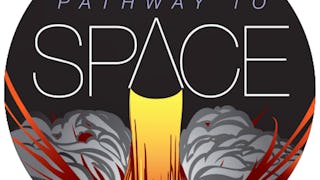Welcome to Course 2 - Getting There and Going Beyond. If you are here, you have successfully completed Course 1 (Our Place in the Cosmos) and are ready for more. There is so much more to learn in Course 2 with 40 learning objectives spread out over 5 weeks and 12 lessons. We will cover all the ways we explore space and near space from planes to rockets to satellites and humans.
Week 1 - We will hit the trail with two lessons on Aeronautics. "Why is a aeronautics in a course about space?" you might be asking yourself. Well aeronautics is used in many aspects of space exploration. It is also how we first started our exploration by getting off the ground. Part 1 connects us with Dr. Brian Argrow, who provides the context and background of aeronautics. Part 2 brings Dr. Gijs de Boer's perspective on the applications and connections with aeronautics and remote sensing. Week 2 - This week will have three lessons that build upon last week's discussion on aeronautics. In Near Space, Dr. Tom Woods and I will explore the science that can be conducted in the Earth's atmosphere at the fringes of space. Mr. Dave Murrow and I will discuss Launch Vehicles and how everything we do in space is dependent on getting through near space and into space on a rocket. And finally, we will discover Orbits with Dr. Steve Nerem. Everything in the cosmos is in motion and that motion can be described by orbits. Getting to space is one thing. Getting around the solar system and beyond is all about orbits. Week 3 - Spacecraft and satellites. So much of what we know about the cosmos was discovered by one of these two vehicles. While they may seem complicated, much of what goes into designing, building, testing, and flying a spacecraft is understandable by everyone. Spacecraft Systems is broken up into three parts. Part 1, we will discuss, the mission design process and systems engineering approach with three guests. David Ferguson, JB Young, and Dr. Nick Bradley. Part 2 will focus on the power, structures, and thermal subsystems as well as mission operations with our guests: Paul Anderson, Kamron Medina, Bruce Davis, Emily Brisnehan, and Kathy Schimmels. And finally Part 3, where we will explore the propulsion and computer subsystems and the methods for testing all the spacecraft systems with Dr. Jeff Ganley, Dr. Lee Jasper, Dr. Adam Pender, Jesse Austin, and Kyle Kemble. Week 4 - This week (and next) we shift focus from space exploration with spacecraft to space exploration with humans. Astronauts have played a vital role in the exploration of the cosmos and have advantages over robotic mission in certain areas. Human Exploration is broken into four parts. In this week, we will cover parts 1 and 2. In Part 1, Dr. Allie Anderson sets the stage for what it takes to have a human in space. In Part 2, we will talk with Astronaut Jim Voss and discuss what it was like to be in space on his five trips there. Week 5 - We will continue our lessons on Human Exploration from Week 4 with two more parts. Part 3 will be with Astronaut Joe Tanner and Part 4 will be Astronaut Rick Hieb. Both will add their perspectives to what it is like to be in space as a human and comment on where humanity should explore next. For those of you counting, that is three astronauts in one course. Pretty awesome huh? So please consider enrolling in course 2 and together we will continue to pull back the curtain on the cosmos together making the unknown, known. Let's continue our journey together in finding your pathway to space.
















